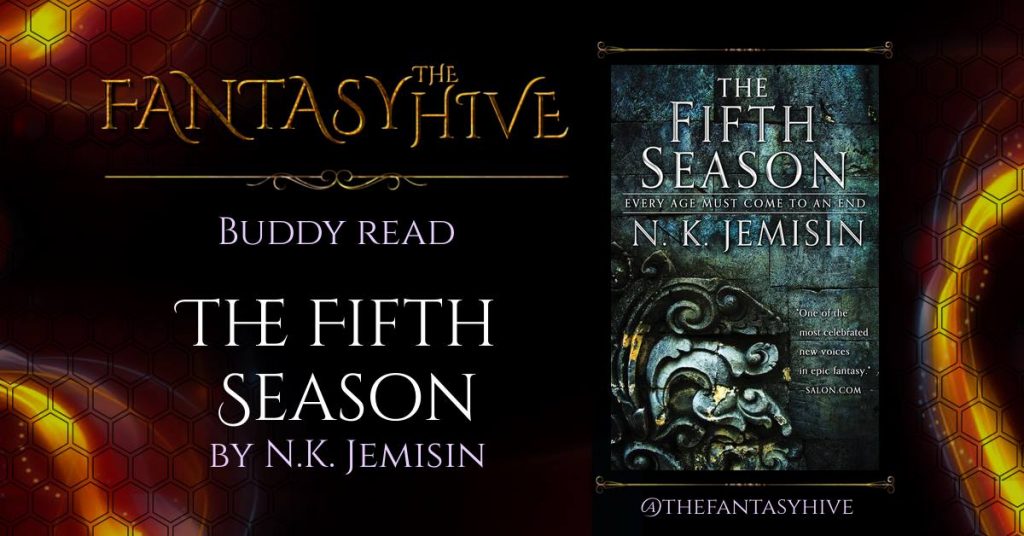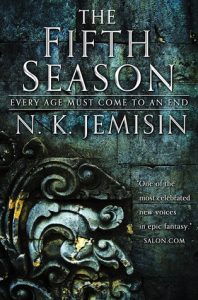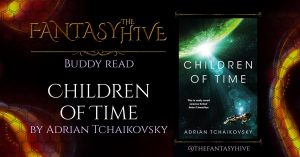The Hive Reads… The Fifth Season by N.K. Jemisin
Welcome to the eighth instalment of our ‘Hive Reads’ feature! (You can read the others here.) After settling on The Fifth Season by N.K. Jemisin as our next read, a bunch of us here at the Hive diligently noted down our thoughts whilst reading throughout the month. You can read the end result below! Though do beware: spoilers abound.
This month’s read is brought to you by the fabulous team of T.O. Munro, G.D. Penman, James Latimer and Laura M. Hughes.

Laura M. Hughes: Welcome, everyone, to the latest Hive Read! This time we’re getting stuck into The Fifth Season by N.K. Jemisin.
As always, let’s begin with first impressions. What are everyone’s thoughts on the cover? Personally, I think it’s sadly dull, and doesn’t reflect the excellence within whatsoever. While I usually like simple covers, this one didn’t get me excited at all, and honestly I think it does the book a bit of a disservice.
James Latimer: Agreed, it’s not great. I suppose they were going for something classy and crossover-ish, but it just doesn’t stand out (and I was in a bookshop just today where it was tabled but didn’t draw the eye – even with HUGO WINNER on it).
G.D. Penman: It is tragically plain, but that has been my experience with all of Jemisin’s books. It might just be that the publisher can’t put anything on the cover without spoilers? I too suspect that they were aiming for class and overshot into bland, then the books were so successful despite the cover that they thought they’d done something right.
Laura: It seems we’re all agreed that the book itself is far, far superior to its cover, so let’s talk about that. We’ll begin with the characters – namely the three POVs, who (SPOILER) are eventually revealed to be the same person at different points in the timeline.
G.D.: I really loved that all three incarnations of the character felt like distinct individuals. Once the timeframe was cleared up they all slotted together nicely into one consistent arc but before then it was quite plausible that they were just three separate women.
T.O. Munro: I enjoyed the diversity of the characters. It felt neither forced, nor bolted on, but formed one of many threads that drove the plot. Particularly Imon and his ability to “successfully fluster” both Syen and Alabaster.
I enjoyed the diversity of the characters. It felt neither forced, nor bolted on, but formed one of many threads that drove the plot.
– T.O. Munro
James: I think Syenite’s arc is the most unique, and the most central. Special kids at magic school and post-apocalyptic survivors have been done before (though they are done very well here), but watching the mage-engineer at work in her hostile world, and her reaction, was extra special.
Laura: I enjoyed all three POVs in their own ways, but Syenite’s arc was by far my favourite, too. All three are sympathetic, strong women fighting against a world that is harsh to all its inhabitants, and especially ones in their situation (i.e. female orogenes).
Speaking of the shifting POVs, what did everyone think about the book’s use of structure? I personally thought the POV shifts and pacing were absolute genius – especially the various character reveals.
T.O.: The three timelines worked brilliantly for me. It’s the kind of book that begs to be reread so that I can appreciate anew all its intricately foreshadowed cleverness.
James: I’m pretty sure I saw the reveals coming, but the structure does work really well. It also supports the worldbuilding (see next) really well by showing us the world in different states/times. The pacing is pretty full-on because there is so much to cover; I feel like there’s not a scene or chapter where something momentous doesn’t happen, which can really leave you on the edge of your seat. (I know this is how books are supposed to be, without filler, but this one is particularly dense, and brilliant.)
The pacing is pretty full-on because there is so much to cover; I feel like there’s not a scene or chapter where something momentous doesn’t happen, which can really leave you on the edge of your seat.
– James Latimer
T.O.: The three story threads worked well, the artifice of second person singular present tense was new to me but still engaging. I’m not a great re-reader, but just dipping into it to remind myself of lines I liked I found myself drawn in again and appreciating the interconnections between the strands.
G.D.: I had a whole theory about the mystery structure in this book when I first read and reviewed it; Jemisin excels in tailoring writing style to the content, and in this book she is writing about survivalism. As such, everything is rationed out carefully, including the information available to the reader. The fact that every new reveal just drags us deeper and deeper into the world and the characters is almost incidental.
Jemisin excels in tailoring writing style to the content, and in this book she is writing about survivalism. As such, everything is rationed out carefully, including the information available to the reader.
– G.D. Penman
Laura: That’s a great way of putting it, Graeme! You and James both mentioned Jemisin’s worldbuilding, and I think we can all agree it’s top class. What in particular did everyone like (or dislike) about the world of The Fifth Season?
T.O.: Love it soooooo much. The literal world building – the restless earth, the seasons of great seismic upheaval, the plate tectonics, the orogenes’ ability to draw on seismic energy to quell it or trigger it… Oh, it is geographistory heaven!
Laura: Yes! One of my favourite parts was the glossary and ‘extra bits’ at the end. I loved reading through the history of all the different seasons. It really gives the reader a sense that this is a living, breathing world (albeit a dystopian, near-unlivable future earth), one which has existed – and will continue to exist – in spite of the characters and story currently giving it shape and meaning.
James: I find wordbuilding like this overwhelming at times – when magic and magic-users have so much power, the consequences are rightly terrifying. But since Jemisin doesn’t shy away from that, or pretend that everything else would be fairly normal despite these powers, it really works. The approach blurs the lines between sci-fi and fantasy, for me, because the world is so alien and the worldbuilding is so central – it’s a classic “what if?” scenario.
 T.O.: I agree about the blurred line between Sci-Fi and fantasy. The language, talking about how many standard deviations from the Sanzed mean a particular individual is, or referring to towns as “Comms” or “Communities,” or even the notions of asphalt roads and electricity make it seem more sci-fi.
T.O.: I agree about the blurred line between Sci-Fi and fantasy. The language, talking about how many standard deviations from the Sanzed mean a particular individual is, or referring to towns as “Comms” or “Communities,” or even the notions of asphalt roads and electricity make it seem more sci-fi.
James: It also helps to present the three different perspectives on it – antibellum, the lead-up, and post-catastrophe – so you can see the full picture. And it definitely left me wanting to read on just to find out how it all fit together.
T.O.: I liked the notion of stonelaw as a kind of survival bible passed down not just between generations but between seasons. Alabaster’s comment that “For all we know, the admonition against changing the lore is itself a recent addition.” made me think of the doctrine of papal infallibility which itself wasn’t promulgated until 1870.
G.D.: As James said, the scale of the worldbuilding here is almost overwhelming, which is why I think that the perspective limitations that we are given are so helpful. We get the necessary information parceled out to us as we reach the relevant event, but the bigger picture is only visible once all three timelines are woven together.
Laura: Interesting points, all! Finally, what did everyone think of the plot?
James: In some respects, I’m still not sure what the plot was, because I feel there is so much to be answered in the next books – this one was about survival and discovery, being very character-focused but on people at the crux of great events.
T.O.: Yes, the ending doesn’t really resolve any of the key questions posed at the start of the book. But a lot has happened and the characters have grown and it is all so beautifully described. I am curious how the structure might carry forward into the next books. Will we get to see where Alabaster has been hiding? There must, I suppose, still be some element of back story. Jeez, I guess I’m just going to have to buy the next book.
G.D.: Because there is so much obfuscation at work it is a little difficult to work out what plot – if any – has unfolded. The majority of this book was definitely character-work and set-up for the stories that are still to unfold, yet somehow I’m leaving it satisfied? Not that it doesn’t spur you on to immediately pick up the sequel, of course…
Laura: Agreed! Never once did I feel anything less than keen to continue turning the pages – a rare feat for a book with so little in the way of concrete plot.
Moving on! Are there any quotations from the book that particularly resonated with anyone?
T.O.: Some lovely descriptive turns of phrase:
“Her speech annoys him in any case; it does not shiver the air the way a human voice would.”
Shivering the air! Has there ever been a better description of sound waves?
“She’s not extraordinarily experienced, but it’s not plate tectonics.”
That made me smile, not so much for the plate tectonics/rocket science analogue, as an implication that the two unwilling lovers’ first encounter will not involve much movement of the Earth.
“The people we love are the ones who hurt us the most, after all.”
G.D.: This is an extremely quotable book:
“Home is what you take with you, not what you leave behind.”
“Tell them they can be great someday, like us. Tell them they belong among us, no matter how we treat them. Tell them they must earn the respect which everyone else receives by default. Them them there is a standard for acceptance; that standard is simply perfection. Kill those who scoff at those contradictions, and tell the rest that the dead deserved annihilation for their weakness and doubt. Then they’ll break themselves trying for what they’ll never achieve.”
“Then she wonders why a part of her is trying to find value in degradation”
Laura: There is indeed a wealth of quotable material in this book, a lot of which gave me goosebumps while reading.
Before we wrap things up, does anyone have any recommendations for books similar to The Fifth Season?
G.D.: Guy Gavriel Kay and Jen Williams are the only contemporary authors that spring to mind for this depth of worldbuilding and character driven fantasy.
Laura: Brilliant! Thanks, Graeme. And thanks for sharing your insights into The Fifth Season, everyone!
That’s it for this month! Thanks again to our wonderful reading team of G.D. Penman, James Latimer, and T.O. Munro (plus me, Laura M. Hughes).
Join us again soon for our group read of Adrian Tchaikovsky’s Hugo Award-winning Children of Time!

